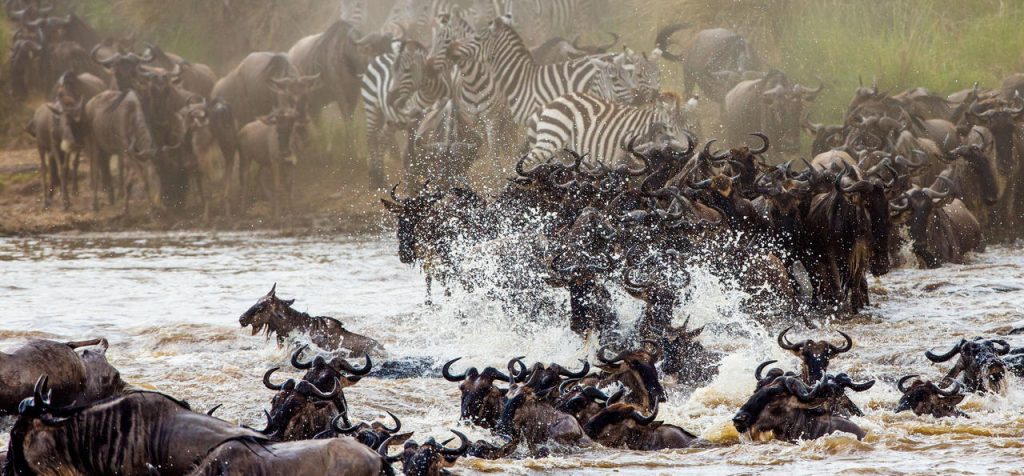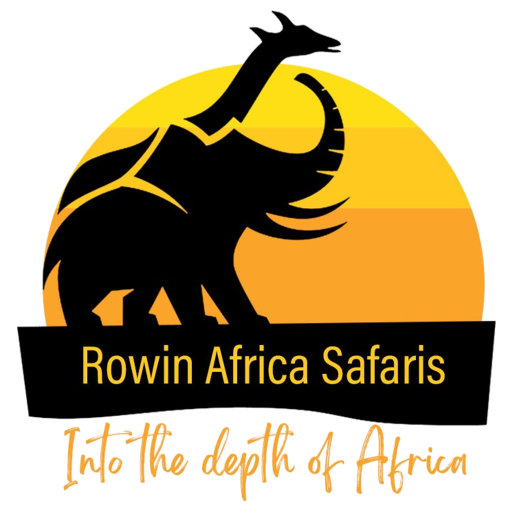Although the Serengeti is home to the Big Five, it is best known for being a host to the Great Migration. This grand annual spectacle is the largest migration of land wildlife in the world and is when millions of wildebeests, followed by gazelles and zebras, seeking greener pastures and dodging predators along the way.
Their circuit journey continues south in the Serengeti before heading west, then north into the Masai Mara National Reserve in Kenya, before returning to their starting point. Normally predators lurk on their heels, pouncing when they see the opportunity, making this journey packed with exhilarating wildlife sightings.
The Serengeti stage is set for the drama to unfold, with varying terrain ranging from volcanic grasslands to vast plains, interrupted by rocky outcrops, snaking rivers and forests.
Although it is wild out there, Serengeti is home to ultra-luxurious lodges, designed to give you the best seat in the house to admire the Serengeti’s show. With a thriving predator population and varied birdlife, there is always something to see here, often around the rivers and watering holes where the animals gather to quench their thirst. With hippo and crocodile waiting to pounce, the water’s edge is the prime position to wait for action.
Whether it is simply to observe a herd of elephant cooling down or lion and crocodile competing over food sources – there is always action unfolding in the Serengeti.
Vast open plains, masses of animals, abundant wildlife – this is similar to what you see in movies and documentaries. The Serengeti National Park is world-famous for the Great Migration when over two million animals pass through its plains.
This is also when the vast expense of grasslands make Serengeti fantastic for spotting predator kills because you can see the whole spectacle clearly.
However, there is more to this wildlife mecca than the Great Migration. From cultural tours to explore the colorful Maasai Mara Villages to hot air balloon safaris to admire the wildlife-packed terrain. Serengeti National Park is a year-round Safari Paradise.

The Great Migration
The Great Migration is a testament to nature’s resilience and majesty. This annual journey is undertaken by over two million wildebeests, zebras and antelope across the Mara-Serengeti Ecosystem. This spectacle captivates guests from all over the world, our Rowin Africa Wildebeest Safari we bring you closer than ever to the epic spectacle, offering an exclusive, front-row seat to one of the nature’s greatest shows.
Understanding the Great Wildebeest Migration: An Epic Cycle of Life
The Great Wildebeest Migration is a continuous cycle of movement influenced by the East African Climate and the wildlife’s quest for fresh grazing opportunities.
Witnessing this natural phenomenon is a unique wildlife experience, but understanding the dynamics of the migration is equally fascinating.
The Great Wildebeest Migration Journey Upacked
The journey begins in the Southern plains of Serengeti National Park in Tanzania around December, with the arrival of the rainy season. Hundreds of thousands of wildebeest are born during this period and as the herds replenish, they begin moving west and then north in search for greener pastures.
By July, the herds have reached the Grumeti River in the Serengeti and the Mara River that divides Tanzania and Kenya. These river crossings are among the most thrilling nature events to witness as the wildebeests confront daunting currents and lurking crocodiles.
After crossing the Mara River, the herds spend time in the lush plains of Masai Mara National Reserve in Kenya before heading back to the Serengeti to complete the cycle.
When to Go
While the Great Migration is a year round phenomenon, the best time to see the Great Migration in Africa largely depends on what you want to experience.
Calving Season (Late January to March)
This period in the Southern Serengeti is when most wildebeest calves are born, offering plenty of dramatic predator – prey action.
Moving North (April – May)
Next, the herds make their way toward the grassier plains of the Serengeti – The Western Corridor.
Grumeti River Crossing (June – July)
During this time, the wildebeests and zebras cross the perilous Grumeti River, trying their best to make it unscathed.
Mara River Crossing (July – August)
This is arguably the most spectacular time to witness the Great Migration as the herds brave crocodile infested waters.
Grazing in the Masai Mara (September – October
The wildebeests take advantage of the abundant grasslands in Masai Mara National Reserve in Kenya.
Back to Tanzania (November – December)
Rain starts to fall again in the South, and the animals start their long trek back to Tanzania, where they will give birth to the next generation of migrators.
Ready to start your journey. Let Us Plan your Trip.
